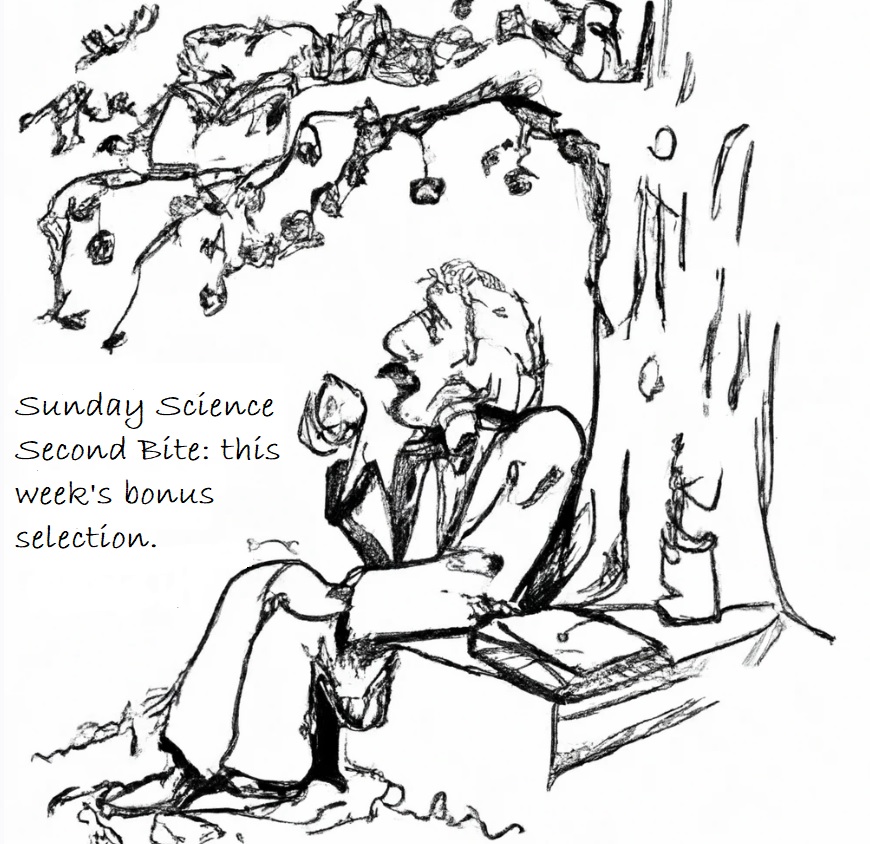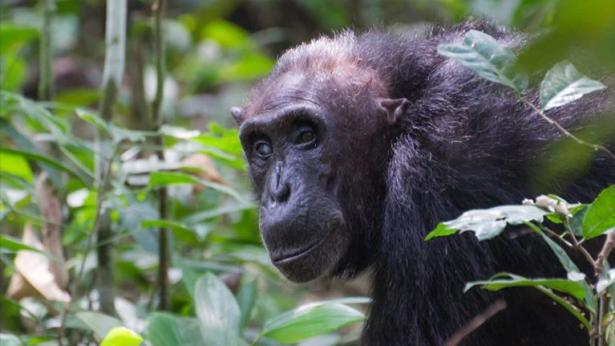Sunday Science: Menopausal Chimpanzees Deepen the Mystery of Why Women Stop Reproducing
The females in a group of wild chimpanzees (Pan troglodytes) are the first non-human primates to be documented experiencing menopause. The finding, published today in Science1, deepens the mystery of why a handful of mammals — including humans and toothed whales (odontocetes) — evolved extended female lifespans beyond their reproductive years.
“There’s so many species who just more or less reproduce until they keel over,” says Tobias Deschner, a primatologist at Osnabrück University in Germany. The riddle, he says, is why a select few buck this trend, ceasing reproduction long before they die.
Researchers followed 185 female members of the Ngogo community of chimpanzees in Kibale National Park, Uganda from 1995 to 2016. The data revealed that, in a pattern similar to that in other chimpanzees and humans, the number of births declined after 30 years old, and ceased altogether by age 50.
The females in a group of wild chimpanzees (Pan troglodytes) are the first non-human primates to be documented experiencing menopause. The finding, published today in Science1, deepens the mystery of why a handful of mammals — including humans and toothed whales (odontocetes) — evolved extended female lifespans beyond their reproductive years.
“There’s so many species who just more or less reproduce until they keel over,” says Tobias Deschner, a primatologist at Osnabrück University in Germany. The riddle, he says, is why a select few buck this trend, ceasing reproduction long before they die.
Researchers followed 185 female members of the Ngogo community of chimpanzees in Kibale National Park, Uganda from 1995 to 2016. The data revealed that, in a pattern similar to that in other chimpanzees and humans, the number of births declined after 30 years old, and ceased altogether by age 50.
Yet, several female chimpanzees continued to live post-reproductive lives, sometimes well into their 60s. Ngogo females spend around one-fifth of their adult lives in this post-reproductive period, roughly half as long as that of hunter-gatherer humans. That number was much larger than the team expected, says Brian Wood, an anthropologist at the University of California, Los Angeles.
The female chimpanzees experience a hormonal transition similar to that seen in humans. Scientists doggedly followed post-reproductive Ngogo females to collect samples of urine as it showered from the trees. The team found a decline in oestrogens and progestins levels, paired with heightened levels of follicle-stimulating hormone and luteinizing hormone in those females — hormones that control ovulation and renewal of the uterine lining after menstruation.
“We always knew that these post-reproductive females were around,” says co-author Kevin Langergraber, a primatologist at Arizona State University in Tempe, who has been studying the Ngogo population since 2001. But he says that it was a surprise to realize that the chimpanzees were undergoing the same physiological process as humans, rather than the decline in fertility being because of illness.
Deschner says that the research highlights the value of long-term observational studies. “The longer such a site exists, the more valuable the data becomes that comes out of that site,” he says. “Just keeping these projects alive is a valuable investment.”
What’s normal?
Whether the Ngogo chimps are an exceptional group remains to be determined. In another paper out today2, Angela Goncalves, a cancer biologist at the German Cancer Research Center in Heidelberg, found that, in animals in zoos, laboratories and other captive settings, cessation of ovulation is widespread. Females from 6 out of 20 mammalian orders for which there were data experience this cessation, leading to a sterile phase of life.
Goncalves says that investigating the cessation of ovulation across species could allow researchers to discover the biological mechanisms involved. Referring to the cessation of ovulation, she says, “it’s still unclear exactly where it starts”, whether the ovaries are responsible, for instance, or the hormone-producing pituitary gland.
Similar to the captive animals in her study, the Ngogo chimps could also be living in protected circumstances, Goncalves says. According to the Ngogo team, the group is isolated and less affected by encroaching human disease and activities than other chimpanzee groups. And in other populations, female chimps typically die soon after the end of their reproductive lives.
Which wild chimpanzee populations are living in conditions that better represent the natural conditions under which they — and their life histories — evolved is unclear. Further studies are needed to settle the question, says Langengraber. “It’ll take a long time and other research sites” to work out whether life beyond reproduction is the norm or the anomaly in chimps, he says.
Evolutionary origins
So far, a long post-reproductive life in wild mammals has only been recorded in five other mammals: orcas (Orcinus orca), short-finned pilot whales (Globicephala macrorhynchus), narwhals (Monodon monoceros), beluga whales (Delphinapterus leucas) and false killer whales (Pseudorca crassidens).
One hypothesis for the evolution of life beyond reproduction — rather than menopause per se — is called the grandmother hypothesis. This suggests that older females could boost their genetic legacy by helping their daughters in raising their offspring. But the hypothesis doesn’t work in chimpanzees, says Wood, because young females leave their family group to mate, and are therefore separated from their mother.
An alternative evolutionary explanation that could explain menopause in Ngogo chimps is the reproductive-conflict hypothesis, which suggests that, within a group, older females stop reproducing to prevent reproductive competition with younger females, who, over time, are increasingly likely to be their granddaughters or another close relation.
But not all biologists agree that menopause is an evolutionary adaption. “There’s even the question of whether this has been at all selected for, or if it’s a byproduct” of other processes, says Goncalves.
Pat Monaghan, an evolutionary ecologist at the University of Glasgow, UK, argues that menopause has evolutionary origins, but not because of social factors3. She says that animals need to ensure that their eggs are furnished with high-quality mitochondria, the energy-producing structures inside cells. Good-quality mitochondria are especially important to brain cells of large-brained mammals, such as humans. By middle-age, females, who are born with their full complement of eggs, simply run out of eggs with good mitochondria. Men do not pass their mitochondria onto their offspring, and so their reproductive lives are not limited.
Langergraber says that in humans, the fact that the timing of a woman’s menopause is inherited suggests that it is an adaptive trait that has been selected for over evolutionary time, rather than a biological quirk that is neither beneficial nor harmful. Because it is heritable, “that means that selection could move it much later”, he says. But that hasn’t happened, so there must be an evolutionary pressure keeping it at around age 50 in humans, he says.
doi: https://doi.org/10.1038/d41586-023-03308-8
References
-
Wood, B. M. et al. Science 382, eadd5473 (2023).
-
Winkler, I. & Goncalves, A. Cell https://doi.org/10.1016/j.cell.2023.09.026 (2023).
-
Monaghan, P. & Ivimey-Cook, E. R. J. Zool. 321, 1–21(2023).
Dyani Lewis is a freelance science journalist based in Melbourne whose reporting runs the gamut from news to features, essays to in-depth investigations. Her usual passions — human evolution and the tensions between conservation and society — have taken a backseat to reporting on the COVID-19 pandemic. She is a four-time contributor to The Best Australian Science Writing and has articles published in Nature, Cosmos, the Monthly, the Guardian, the Atlantic (via Undark), and Science.
Nature: Aims & Scope
Nature is a weekly international journal publishing the finest peer-reviewed research in all fields of science and technology on the basis of its originality, importance, interdisciplinary interest, timeliness, accessibility, elegance and surprising conclusions. Nature also provides rapid, authoritative, insightful and arresting news and interpretation of topical and coming trends affecting science, scientists and the wider public.
Nature's mission statement
First, to serve scientists through prompt publication of significant advances in any branch of science, and to provide a forum for the reporting and discussion of news and issues concerning science. Second, to ensure that the results of science are rapidly disseminated to the public throughout the world, in a fashion that conveys their significance for knowledge, culture and daily life.
Nature's original mission statement was published for the first time on 11 November 1869.
About the Editors
Like the other Nature titles, Nature has no external editorial board. Instead, all editorial decisions are made by a team of full-time professional editors. Information about the scientific background of the editors may be found here.

You Can Drink the Tap Water in These 50 Countries — Maybe
According to the CDC, 50 countries worldwide have drinkable tap water. But look closer, and the picture is more nuanced.
Frank Jacobs
Strange Maps
October 24, 2023


Spread the word